Adolescent Development: Media, Theories, and Societal Issues Analysis
VerifiedAdded on 2021/04/16
|10
|2723
|118
Essay
AI Summary
This essay delves into the multifaceted realm of adolescent development, exploring behaviors reported in the media, such as violence, bullying, and substance use, and linking them to established developmental theories like Piaget's cognitive development and Kolb's learning styles. It examines the influence of socio-cultural factors on learning and development, highlighting the impact of family, peers, and culture. The essay also addresses the issues adolescents face in school and society, including mood swings, egocentrism, stress, and pressure related to self-discovery and social expectations. It concludes by emphasizing the transitional nature of adolescence and the various physical and psychological changes that adolescents experience, providing a comprehensive overview of the challenges and complexities of this developmental stage.
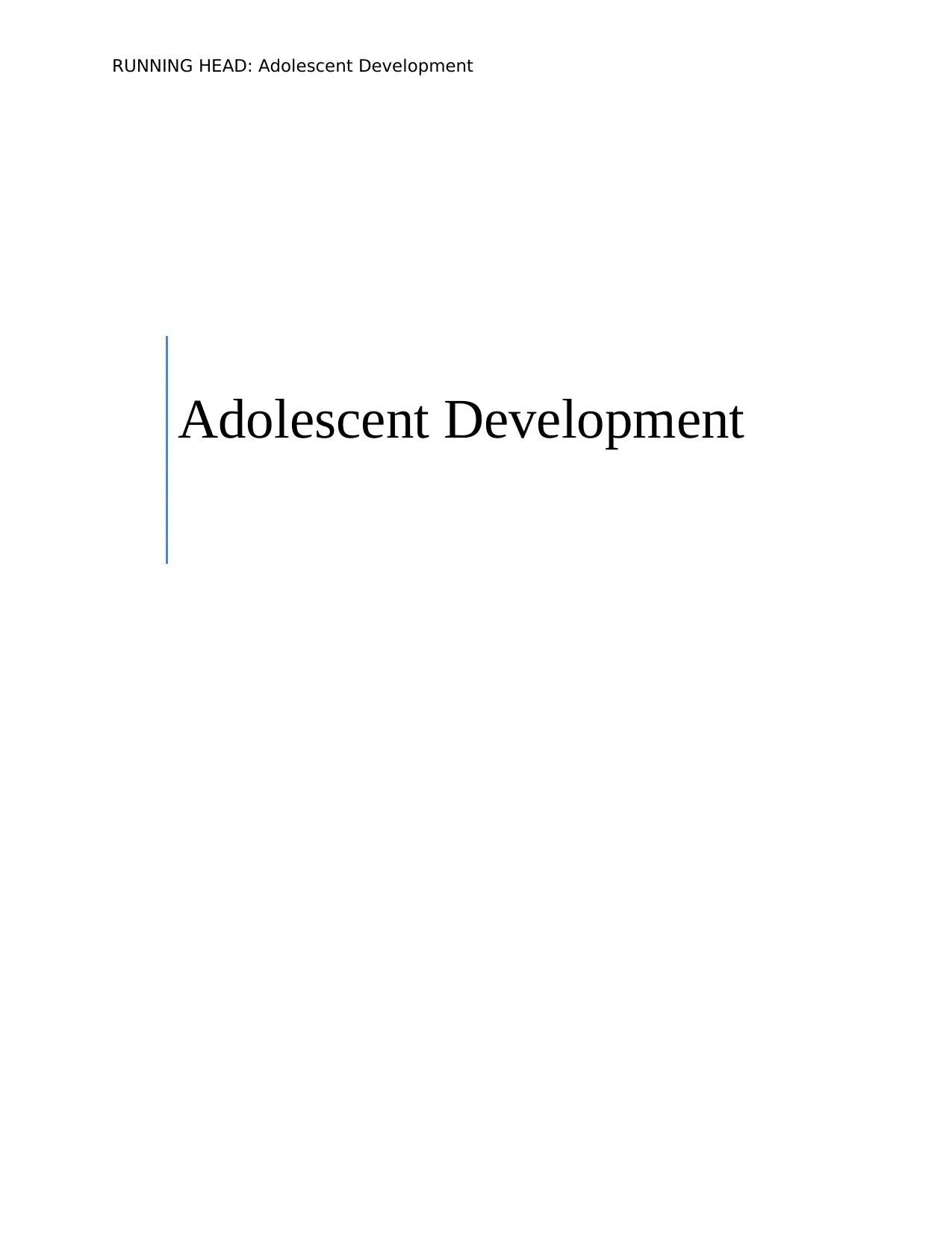
RUNNING HEAD: Adolescent Development
Adolescent Development
Adolescent Development
Paraphrase This Document
Need a fresh take? Get an instant paraphrase of this document with our AI Paraphraser
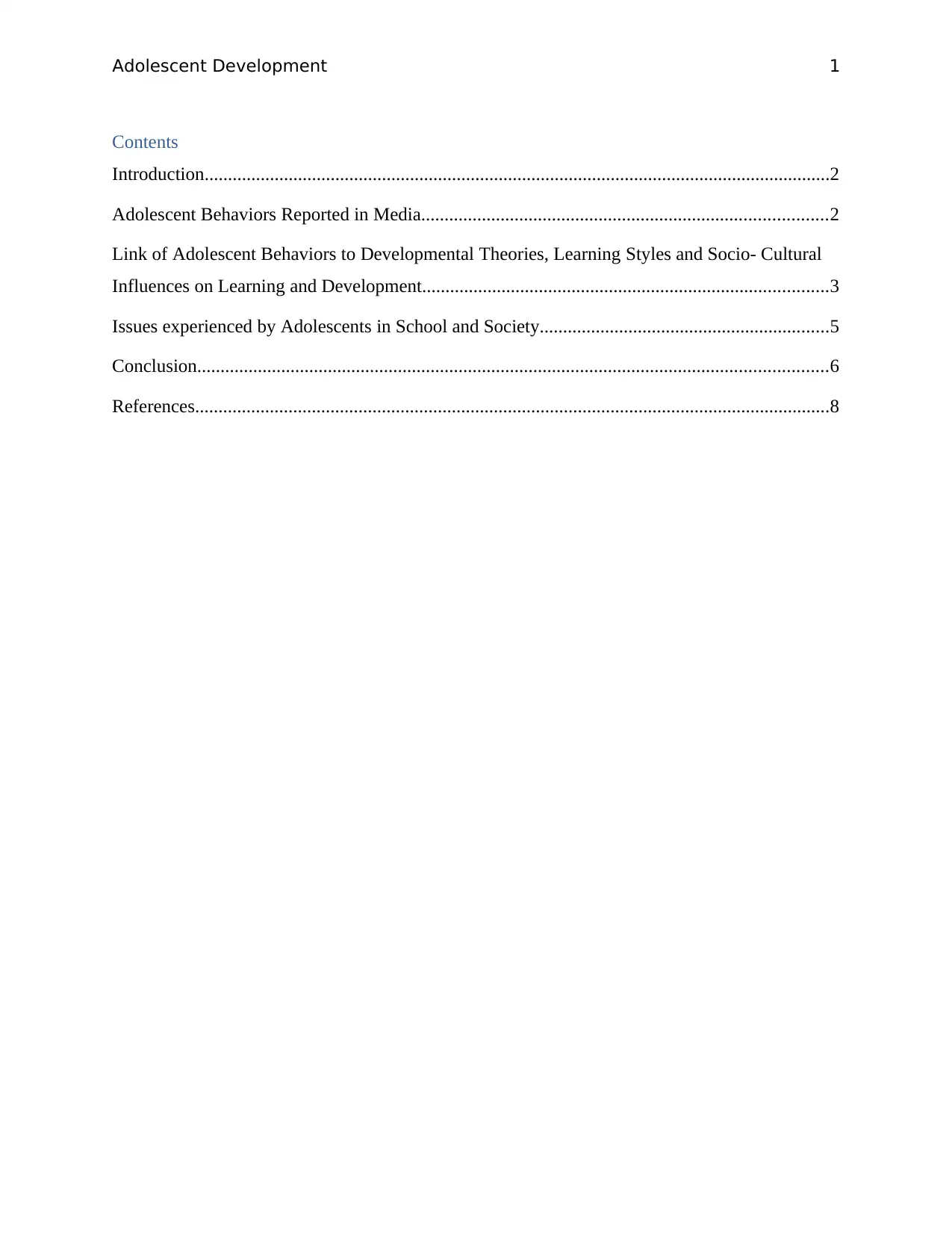
Adolescent Development 1
Contents
Introduction......................................................................................................................................2
Adolescent Behaviors Reported in Media.......................................................................................2
Link of Adolescent Behaviors to Developmental Theories, Learning Styles and Socio- Cultural
Influences on Learning and Development.......................................................................................3
Issues experienced by Adolescents in School and Society..............................................................5
Conclusion.......................................................................................................................................6
References........................................................................................................................................8
Contents
Introduction......................................................................................................................................2
Adolescent Behaviors Reported in Media.......................................................................................2
Link of Adolescent Behaviors to Developmental Theories, Learning Styles and Socio- Cultural
Influences on Learning and Development.......................................................................................3
Issues experienced by Adolescents in School and Society..............................................................5
Conclusion.......................................................................................................................................6
References........................................................................................................................................8
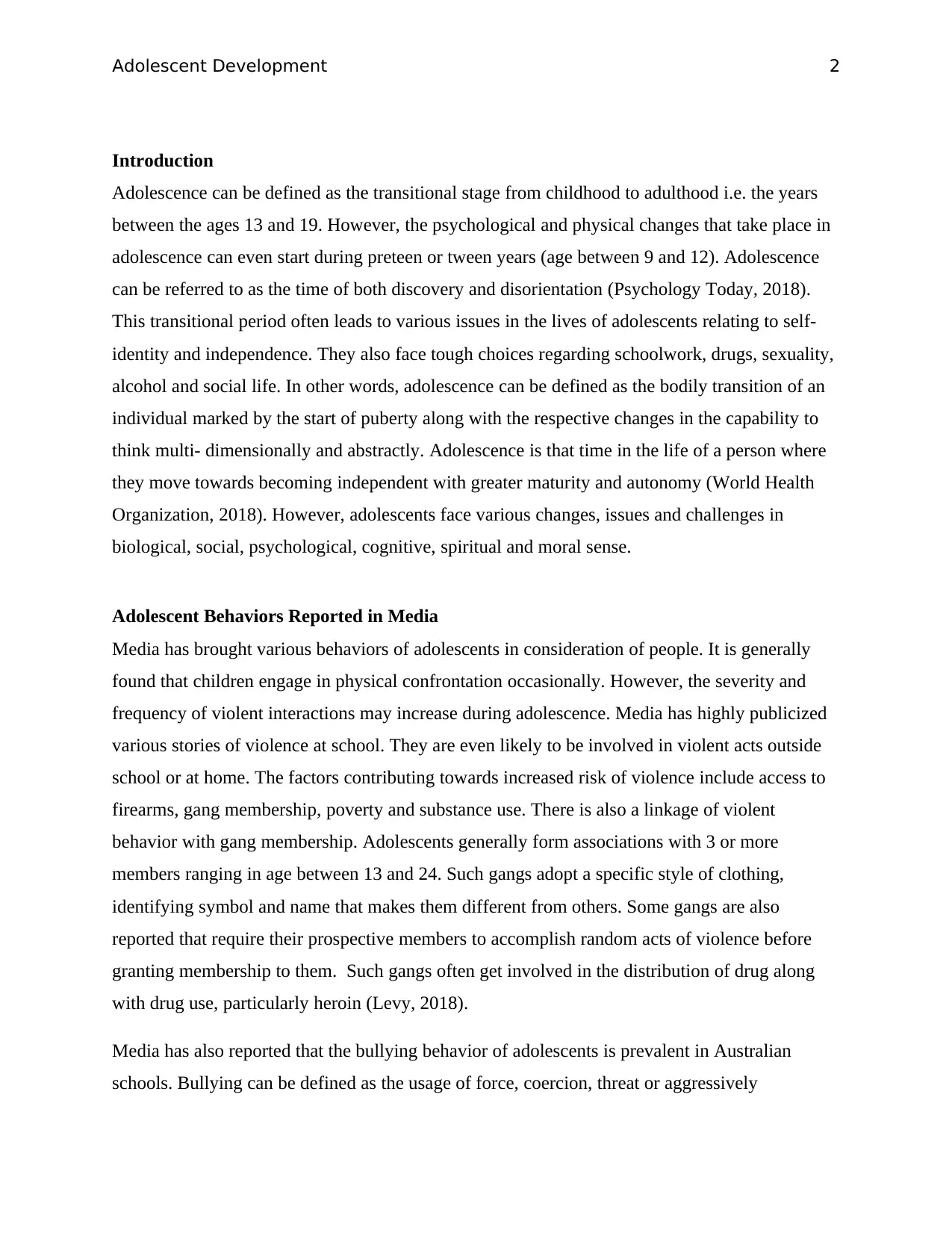
Adolescent Development 2
Introduction
Adolescence can be defined as the transitional stage from childhood to adulthood i.e. the years
between the ages 13 and 19. However, the psychological and physical changes that take place in
adolescence can even start during preteen or tween years (age between 9 and 12). Adolescence
can be referred to as the time of both discovery and disorientation (Psychology Today, 2018).
This transitional period often leads to various issues in the lives of adolescents relating to self-
identity and independence. They also face tough choices regarding schoolwork, drugs, sexuality,
alcohol and social life. In other words, adolescence can be defined as the bodily transition of an
individual marked by the start of puberty along with the respective changes in the capability to
think multi- dimensionally and abstractly. Adolescence is that time in the life of a person where
they move towards becoming independent with greater maturity and autonomy (World Health
Organization, 2018). However, adolescents face various changes, issues and challenges in
biological, social, psychological, cognitive, spiritual and moral sense.
Adolescent Behaviors Reported in Media
Media has brought various behaviors of adolescents in consideration of people. It is generally
found that children engage in physical confrontation occasionally. However, the severity and
frequency of violent interactions may increase during adolescence. Media has highly publicized
various stories of violence at school. They are even likely to be involved in violent acts outside
school or at home. The factors contributing towards increased risk of violence include access to
firearms, gang membership, poverty and substance use. There is also a linkage of violent
behavior with gang membership. Adolescents generally form associations with 3 or more
members ranging in age between 13 and 24. Such gangs adopt a specific style of clothing,
identifying symbol and name that makes them different from others. Some gangs are also
reported that require their prospective members to accomplish random acts of violence before
granting membership to them. Such gangs often get involved in the distribution of drug along
with drug use, particularly heroin (Levy, 2018).
Media has also reported that the bullying behavior of adolescents is prevalent in Australian
schools. Bullying can be defined as the usage of force, coercion, threat or aggressively
Introduction
Adolescence can be defined as the transitional stage from childhood to adulthood i.e. the years
between the ages 13 and 19. However, the psychological and physical changes that take place in
adolescence can even start during preteen or tween years (age between 9 and 12). Adolescence
can be referred to as the time of both discovery and disorientation (Psychology Today, 2018).
This transitional period often leads to various issues in the lives of adolescents relating to self-
identity and independence. They also face tough choices regarding schoolwork, drugs, sexuality,
alcohol and social life. In other words, adolescence can be defined as the bodily transition of an
individual marked by the start of puberty along with the respective changes in the capability to
think multi- dimensionally and abstractly. Adolescence is that time in the life of a person where
they move towards becoming independent with greater maturity and autonomy (World Health
Organization, 2018). However, adolescents face various changes, issues and challenges in
biological, social, psychological, cognitive, spiritual and moral sense.
Adolescent Behaviors Reported in Media
Media has brought various behaviors of adolescents in consideration of people. It is generally
found that children engage in physical confrontation occasionally. However, the severity and
frequency of violent interactions may increase during adolescence. Media has highly publicized
various stories of violence at school. They are even likely to be involved in violent acts outside
school or at home. The factors contributing towards increased risk of violence include access to
firearms, gang membership, poverty and substance use. There is also a linkage of violent
behavior with gang membership. Adolescents generally form associations with 3 or more
members ranging in age between 13 and 24. Such gangs adopt a specific style of clothing,
identifying symbol and name that makes them different from others. Some gangs are also
reported that require their prospective members to accomplish random acts of violence before
granting membership to them. Such gangs often get involved in the distribution of drug along
with drug use, particularly heroin (Levy, 2018).
Media has also reported that the bullying behavior of adolescents is prevalent in Australian
schools. Bullying can be defined as the usage of force, coercion, threat or aggressively
⊘ This is a preview!⊘
Do you want full access?
Subscribe today to unlock all pages.

Trusted by 1+ million students worldwide
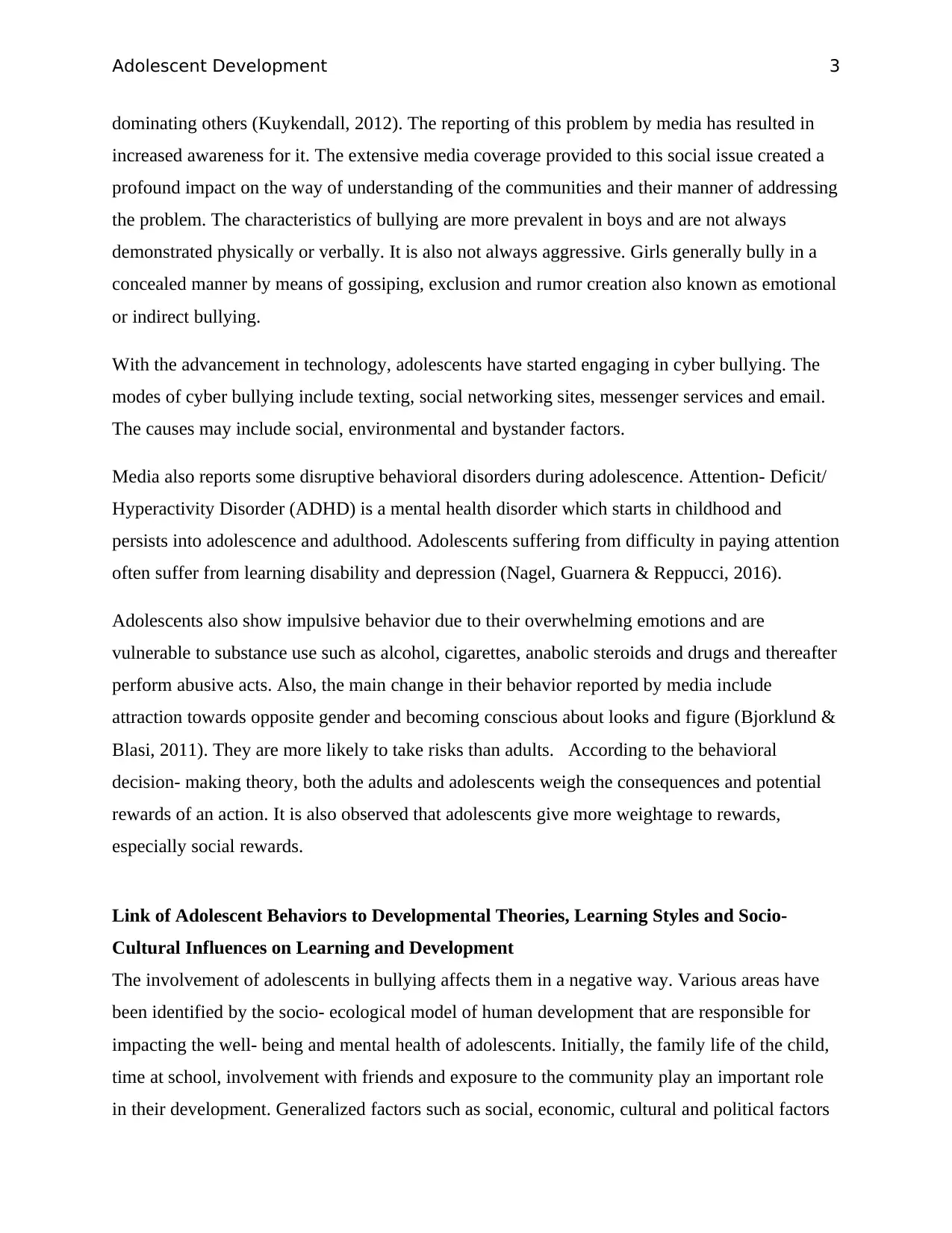
Adolescent Development 3
dominating others (Kuykendall, 2012). The reporting of this problem by media has resulted in
increased awareness for it. The extensive media coverage provided to this social issue created a
profound impact on the way of understanding of the communities and their manner of addressing
the problem. The characteristics of bullying are more prevalent in boys and are not always
demonstrated physically or verbally. It is also not always aggressive. Girls generally bully in a
concealed manner by means of gossiping, exclusion and rumor creation also known as emotional
or indirect bullying.
With the advancement in technology, adolescents have started engaging in cyber bullying. The
modes of cyber bullying include texting, social networking sites, messenger services and email.
The causes may include social, environmental and bystander factors.
Media also reports some disruptive behavioral disorders during adolescence. Attention- Deficit/
Hyperactivity Disorder (ADHD) is a mental health disorder which starts in childhood and
persists into adolescence and adulthood. Adolescents suffering from difficulty in paying attention
often suffer from learning disability and depression (Nagel, Guarnera & Reppucci, 2016).
Adolescents also show impulsive behavior due to their overwhelming emotions and are
vulnerable to substance use such as alcohol, cigarettes, anabolic steroids and drugs and thereafter
perform abusive acts. Also, the main change in their behavior reported by media include
attraction towards opposite gender and becoming conscious about looks and figure (Bjorklund &
Blasi, 2011). They are more likely to take risks than adults. According to the behavioral
decision- making theory, both the adults and adolescents weigh the consequences and potential
rewards of an action. It is also observed that adolescents give more weightage to rewards,
especially social rewards.
Link of Adolescent Behaviors to Developmental Theories, Learning Styles and Socio-
Cultural Influences on Learning and Development
The involvement of adolescents in bullying affects them in a negative way. Various areas have
been identified by the socio- ecological model of human development that are responsible for
impacting the well- being and mental health of adolescents. Initially, the family life of the child,
time at school, involvement with friends and exposure to the community play an important role
in their development. Generalized factors such as social, economic, cultural and political factors
dominating others (Kuykendall, 2012). The reporting of this problem by media has resulted in
increased awareness for it. The extensive media coverage provided to this social issue created a
profound impact on the way of understanding of the communities and their manner of addressing
the problem. The characteristics of bullying are more prevalent in boys and are not always
demonstrated physically or verbally. It is also not always aggressive. Girls generally bully in a
concealed manner by means of gossiping, exclusion and rumor creation also known as emotional
or indirect bullying.
With the advancement in technology, adolescents have started engaging in cyber bullying. The
modes of cyber bullying include texting, social networking sites, messenger services and email.
The causes may include social, environmental and bystander factors.
Media also reports some disruptive behavioral disorders during adolescence. Attention- Deficit/
Hyperactivity Disorder (ADHD) is a mental health disorder which starts in childhood and
persists into adolescence and adulthood. Adolescents suffering from difficulty in paying attention
often suffer from learning disability and depression (Nagel, Guarnera & Reppucci, 2016).
Adolescents also show impulsive behavior due to their overwhelming emotions and are
vulnerable to substance use such as alcohol, cigarettes, anabolic steroids and drugs and thereafter
perform abusive acts. Also, the main change in their behavior reported by media include
attraction towards opposite gender and becoming conscious about looks and figure (Bjorklund &
Blasi, 2011). They are more likely to take risks than adults. According to the behavioral
decision- making theory, both the adults and adolescents weigh the consequences and potential
rewards of an action. It is also observed that adolescents give more weightage to rewards,
especially social rewards.
Link of Adolescent Behaviors to Developmental Theories, Learning Styles and Socio-
Cultural Influences on Learning and Development
The involvement of adolescents in bullying affects them in a negative way. Various areas have
been identified by the socio- ecological model of human development that are responsible for
impacting the well- being and mental health of adolescents. Initially, the family life of the child,
time at school, involvement with friends and exposure to the community play an important role
in their development. Generalized factors such as social, economic, cultural and political factors
Paraphrase This Document
Need a fresh take? Get an instant paraphrase of this document with our AI Paraphraser
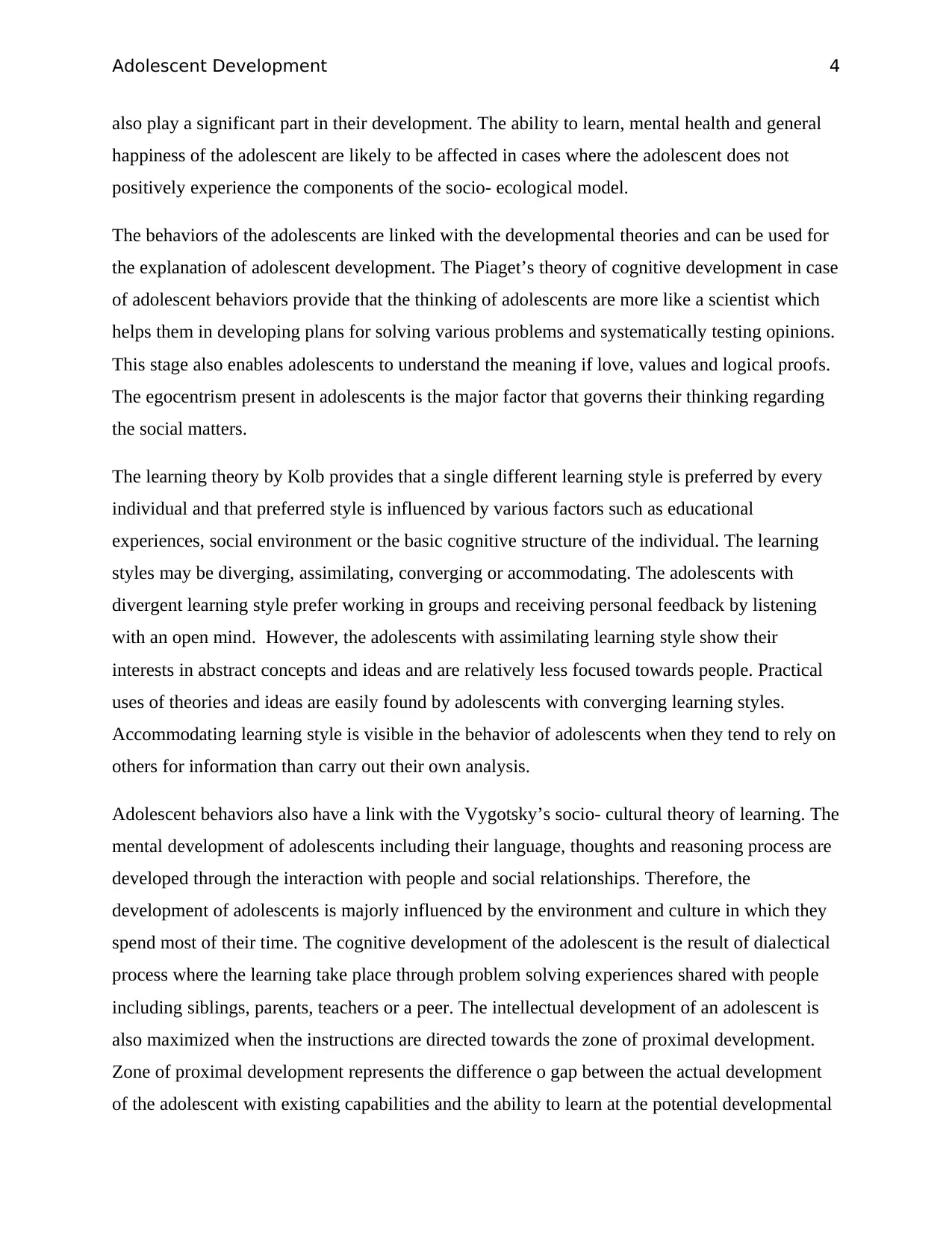
Adolescent Development 4
also play a significant part in their development. The ability to learn, mental health and general
happiness of the adolescent are likely to be affected in cases where the adolescent does not
positively experience the components of the socio- ecological model.
The behaviors of the adolescents are linked with the developmental theories and can be used for
the explanation of adolescent development. The Piaget’s theory of cognitive development in case
of adolescent behaviors provide that the thinking of adolescents are more like a scientist which
helps them in developing plans for solving various problems and systematically testing opinions.
This stage also enables adolescents to understand the meaning if love, values and logical proofs.
The egocentrism present in adolescents is the major factor that governs their thinking regarding
the social matters.
The learning theory by Kolb provides that a single different learning style is preferred by every
individual and that preferred style is influenced by various factors such as educational
experiences, social environment or the basic cognitive structure of the individual. The learning
styles may be diverging, assimilating, converging or accommodating. The adolescents with
divergent learning style prefer working in groups and receiving personal feedback by listening
with an open mind. However, the adolescents with assimilating learning style show their
interests in abstract concepts and ideas and are relatively less focused towards people. Practical
uses of theories and ideas are easily found by adolescents with converging learning styles.
Accommodating learning style is visible in the behavior of adolescents when they tend to rely on
others for information than carry out their own analysis.
Adolescent behaviors also have a link with the Vygotsky’s socio- cultural theory of learning. The
mental development of adolescents including their language, thoughts and reasoning process are
developed through the interaction with people and social relationships. Therefore, the
development of adolescents is majorly influenced by the environment and culture in which they
spend most of their time. The cognitive development of the adolescent is the result of dialectical
process where the learning take place through problem solving experiences shared with people
including siblings, parents, teachers or a peer. The intellectual development of an adolescent is
also maximized when the instructions are directed towards the zone of proximal development.
Zone of proximal development represents the difference o gap between the actual development
of the adolescent with existing capabilities and the ability to learn at the potential developmental
also play a significant part in their development. The ability to learn, mental health and general
happiness of the adolescent are likely to be affected in cases where the adolescent does not
positively experience the components of the socio- ecological model.
The behaviors of the adolescents are linked with the developmental theories and can be used for
the explanation of adolescent development. The Piaget’s theory of cognitive development in case
of adolescent behaviors provide that the thinking of adolescents are more like a scientist which
helps them in developing plans for solving various problems and systematically testing opinions.
This stage also enables adolescents to understand the meaning if love, values and logical proofs.
The egocentrism present in adolescents is the major factor that governs their thinking regarding
the social matters.
The learning theory by Kolb provides that a single different learning style is preferred by every
individual and that preferred style is influenced by various factors such as educational
experiences, social environment or the basic cognitive structure of the individual. The learning
styles may be diverging, assimilating, converging or accommodating. The adolescents with
divergent learning style prefer working in groups and receiving personal feedback by listening
with an open mind. However, the adolescents with assimilating learning style show their
interests in abstract concepts and ideas and are relatively less focused towards people. Practical
uses of theories and ideas are easily found by adolescents with converging learning styles.
Accommodating learning style is visible in the behavior of adolescents when they tend to rely on
others for information than carry out their own analysis.
Adolescent behaviors also have a link with the Vygotsky’s socio- cultural theory of learning. The
mental development of adolescents including their language, thoughts and reasoning process are
developed through the interaction with people and social relationships. Therefore, the
development of adolescents is majorly influenced by the environment and culture in which they
spend most of their time. The cognitive development of the adolescent is the result of dialectical
process where the learning take place through problem solving experiences shared with people
including siblings, parents, teachers or a peer. The intellectual development of an adolescent is
also maximized when the instructions are directed towards the zone of proximal development.
Zone of proximal development represents the difference o gap between the actual development
of the adolescent with existing capabilities and the ability to learn at the potential developmental
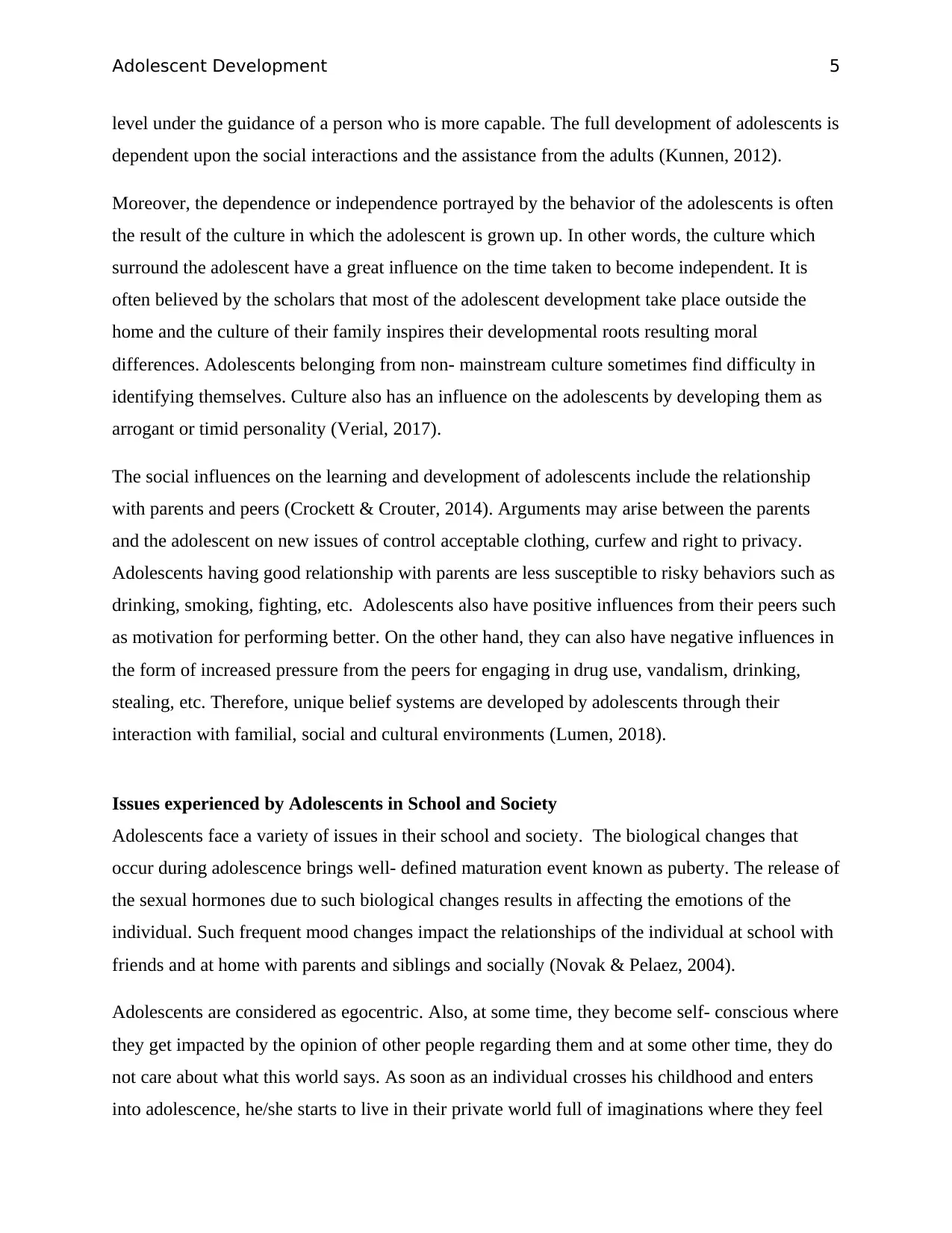
Adolescent Development 5
level under the guidance of a person who is more capable. The full development of adolescents is
dependent upon the social interactions and the assistance from the adults (Kunnen, 2012).
Moreover, the dependence or independence portrayed by the behavior of the adolescents is often
the result of the culture in which the adolescent is grown up. In other words, the culture which
surround the adolescent have a great influence on the time taken to become independent. It is
often believed by the scholars that most of the adolescent development take place outside the
home and the culture of their family inspires their developmental roots resulting moral
differences. Adolescents belonging from non- mainstream culture sometimes find difficulty in
identifying themselves. Culture also has an influence on the adolescents by developing them as
arrogant or timid personality (Verial, 2017).
The social influences on the learning and development of adolescents include the relationship
with parents and peers (Crockett & Crouter, 2014). Arguments may arise between the parents
and the adolescent on new issues of control acceptable clothing, curfew and right to privacy.
Adolescents having good relationship with parents are less susceptible to risky behaviors such as
drinking, smoking, fighting, etc. Adolescents also have positive influences from their peers such
as motivation for performing better. On the other hand, they can also have negative influences in
the form of increased pressure from the peers for engaging in drug use, vandalism, drinking,
stealing, etc. Therefore, unique belief systems are developed by adolescents through their
interaction with familial, social and cultural environments (Lumen, 2018).
Issues experienced by Adolescents in School and Society
Adolescents face a variety of issues in their school and society. The biological changes that
occur during adolescence brings well- defined maturation event known as puberty. The release of
the sexual hormones due to such biological changes results in affecting the emotions of the
individual. Such frequent mood changes impact the relationships of the individual at school with
friends and at home with parents and siblings and socially (Novak & Pelaez, 2004).
Adolescents are considered as egocentric. Also, at some time, they become self- conscious where
they get impacted by the opinion of other people regarding them and at some other time, they do
not care about what this world says. As soon as an individual crosses his childhood and enters
into adolescence, he/she starts to live in their private world full of imaginations where they feel
level under the guidance of a person who is more capable. The full development of adolescents is
dependent upon the social interactions and the assistance from the adults (Kunnen, 2012).
Moreover, the dependence or independence portrayed by the behavior of the adolescents is often
the result of the culture in which the adolescent is grown up. In other words, the culture which
surround the adolescent have a great influence on the time taken to become independent. It is
often believed by the scholars that most of the adolescent development take place outside the
home and the culture of their family inspires their developmental roots resulting moral
differences. Adolescents belonging from non- mainstream culture sometimes find difficulty in
identifying themselves. Culture also has an influence on the adolescents by developing them as
arrogant or timid personality (Verial, 2017).
The social influences on the learning and development of adolescents include the relationship
with parents and peers (Crockett & Crouter, 2014). Arguments may arise between the parents
and the adolescent on new issues of control acceptable clothing, curfew and right to privacy.
Adolescents having good relationship with parents are less susceptible to risky behaviors such as
drinking, smoking, fighting, etc. Adolescents also have positive influences from their peers such
as motivation for performing better. On the other hand, they can also have negative influences in
the form of increased pressure from the peers for engaging in drug use, vandalism, drinking,
stealing, etc. Therefore, unique belief systems are developed by adolescents through their
interaction with familial, social and cultural environments (Lumen, 2018).
Issues experienced by Adolescents in School and Society
Adolescents face a variety of issues in their school and society. The biological changes that
occur during adolescence brings well- defined maturation event known as puberty. The release of
the sexual hormones due to such biological changes results in affecting the emotions of the
individual. Such frequent mood changes impact the relationships of the individual at school with
friends and at home with parents and siblings and socially (Novak & Pelaez, 2004).
Adolescents are considered as egocentric. Also, at some time, they become self- conscious where
they get impacted by the opinion of other people regarding them and at some other time, they do
not care about what this world says. As soon as an individual crosses his childhood and enters
into adolescence, he/she starts to live in their private world full of imaginations where they feel
⊘ This is a preview!⊘
Do you want full access?
Subscribe today to unlock all pages.

Trusted by 1+ million students worldwide
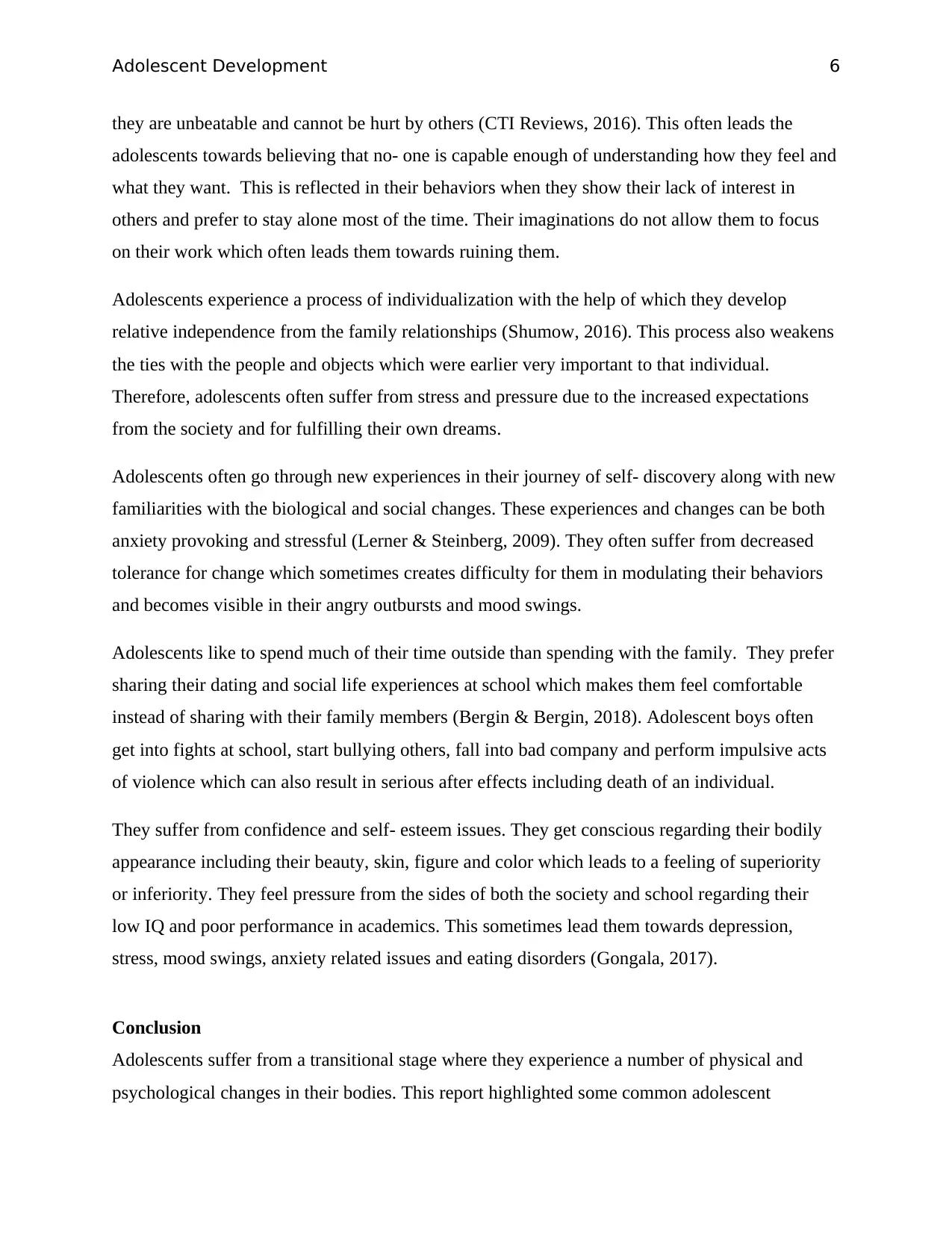
Adolescent Development 6
they are unbeatable and cannot be hurt by others (CTI Reviews, 2016). This often leads the
adolescents towards believing that no- one is capable enough of understanding how they feel and
what they want. This is reflected in their behaviors when they show their lack of interest in
others and prefer to stay alone most of the time. Their imaginations do not allow them to focus
on their work which often leads them towards ruining them.
Adolescents experience a process of individualization with the help of which they develop
relative independence from the family relationships (Shumow, 2016). This process also weakens
the ties with the people and objects which were earlier very important to that individual.
Therefore, adolescents often suffer from stress and pressure due to the increased expectations
from the society and for fulfilling their own dreams.
Adolescents often go through new experiences in their journey of self- discovery along with new
familiarities with the biological and social changes. These experiences and changes can be both
anxiety provoking and stressful (Lerner & Steinberg, 2009). They often suffer from decreased
tolerance for change which sometimes creates difficulty for them in modulating their behaviors
and becomes visible in their angry outbursts and mood swings.
Adolescents like to spend much of their time outside than spending with the family. They prefer
sharing their dating and social life experiences at school which makes them feel comfortable
instead of sharing with their family members (Bergin & Bergin, 2018). Adolescent boys often
get into fights at school, start bullying others, fall into bad company and perform impulsive acts
of violence which can also result in serious after effects including death of an individual.
They suffer from confidence and self- esteem issues. They get conscious regarding their bodily
appearance including their beauty, skin, figure and color which leads to a feeling of superiority
or inferiority. They feel pressure from the sides of both the society and school regarding their
low IQ and poor performance in academics. This sometimes lead them towards depression,
stress, mood swings, anxiety related issues and eating disorders (Gongala, 2017).
Conclusion
Adolescents suffer from a transitional stage where they experience a number of physical and
psychological changes in their bodies. This report highlighted some common adolescent
they are unbeatable and cannot be hurt by others (CTI Reviews, 2016). This often leads the
adolescents towards believing that no- one is capable enough of understanding how they feel and
what they want. This is reflected in their behaviors when they show their lack of interest in
others and prefer to stay alone most of the time. Their imaginations do not allow them to focus
on their work which often leads them towards ruining them.
Adolescents experience a process of individualization with the help of which they develop
relative independence from the family relationships (Shumow, 2016). This process also weakens
the ties with the people and objects which were earlier very important to that individual.
Therefore, adolescents often suffer from stress and pressure due to the increased expectations
from the society and for fulfilling their own dreams.
Adolescents often go through new experiences in their journey of self- discovery along with new
familiarities with the biological and social changes. These experiences and changes can be both
anxiety provoking and stressful (Lerner & Steinberg, 2009). They often suffer from decreased
tolerance for change which sometimes creates difficulty for them in modulating their behaviors
and becomes visible in their angry outbursts and mood swings.
Adolescents like to spend much of their time outside than spending with the family. They prefer
sharing their dating and social life experiences at school which makes them feel comfortable
instead of sharing with their family members (Bergin & Bergin, 2018). Adolescent boys often
get into fights at school, start bullying others, fall into bad company and perform impulsive acts
of violence which can also result in serious after effects including death of an individual.
They suffer from confidence and self- esteem issues. They get conscious regarding their bodily
appearance including their beauty, skin, figure and color which leads to a feeling of superiority
or inferiority. They feel pressure from the sides of both the society and school regarding their
low IQ and poor performance in academics. This sometimes lead them towards depression,
stress, mood swings, anxiety related issues and eating disorders (Gongala, 2017).
Conclusion
Adolescents suffer from a transitional stage where they experience a number of physical and
psychological changes in their bodies. This report highlighted some common adolescent
Paraphrase This Document
Need a fresh take? Get an instant paraphrase of this document with our AI Paraphraser
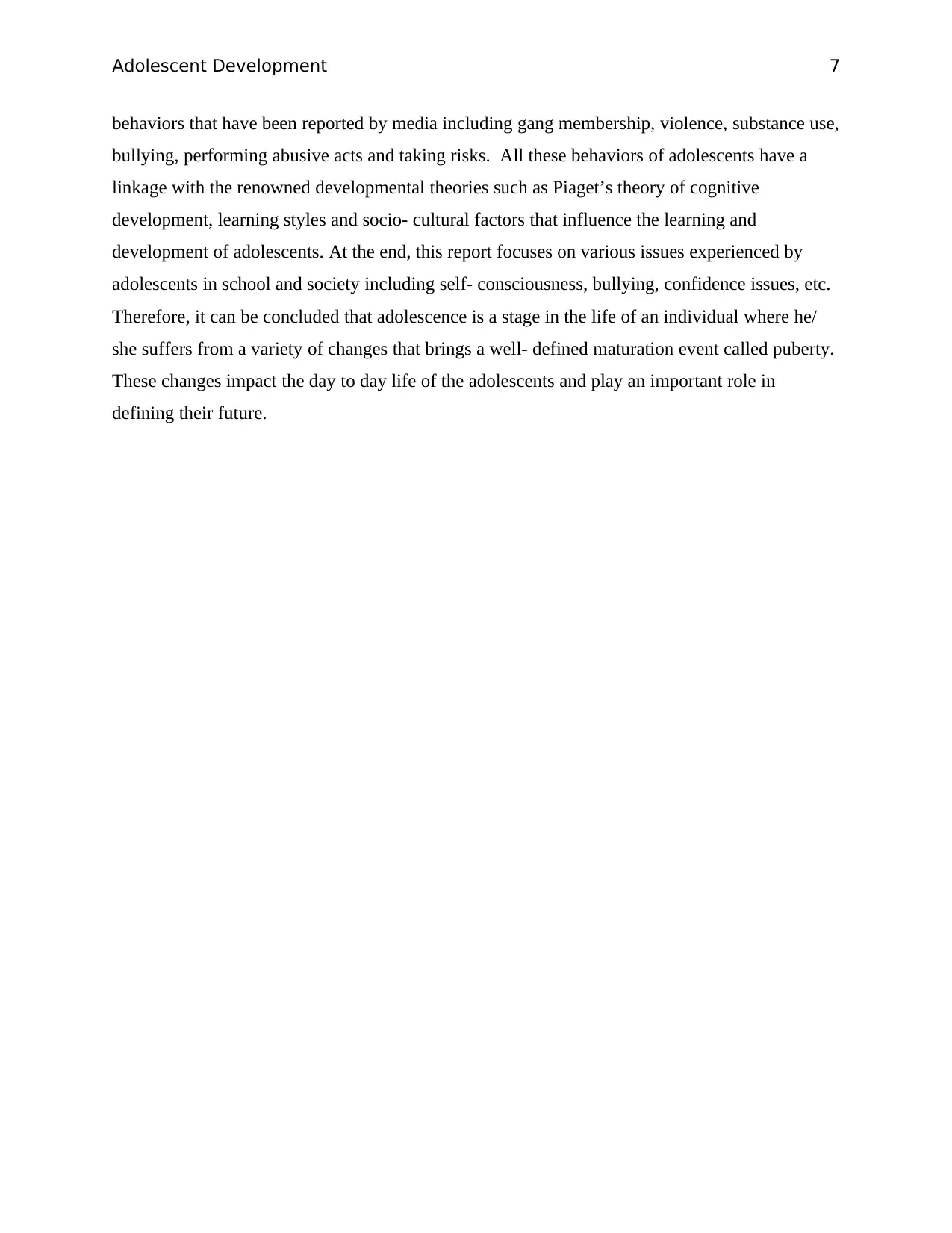
Adolescent Development 7
behaviors that have been reported by media including gang membership, violence, substance use,
bullying, performing abusive acts and taking risks. All these behaviors of adolescents have a
linkage with the renowned developmental theories such as Piaget’s theory of cognitive
development, learning styles and socio- cultural factors that influence the learning and
development of adolescents. At the end, this report focuses on various issues experienced by
adolescents in school and society including self- consciousness, bullying, confidence issues, etc.
Therefore, it can be concluded that adolescence is a stage in the life of an individual where he/
she suffers from a variety of changes that brings a well- defined maturation event called puberty.
These changes impact the day to day life of the adolescents and play an important role in
defining their future.
behaviors that have been reported by media including gang membership, violence, substance use,
bullying, performing abusive acts and taking risks. All these behaviors of adolescents have a
linkage with the renowned developmental theories such as Piaget’s theory of cognitive
development, learning styles and socio- cultural factors that influence the learning and
development of adolescents. At the end, this report focuses on various issues experienced by
adolescents in school and society including self- consciousness, bullying, confidence issues, etc.
Therefore, it can be concluded that adolescence is a stage in the life of an individual where he/
she suffers from a variety of changes that brings a well- defined maturation event called puberty.
These changes impact the day to day life of the adolescents and play an important role in
defining their future.
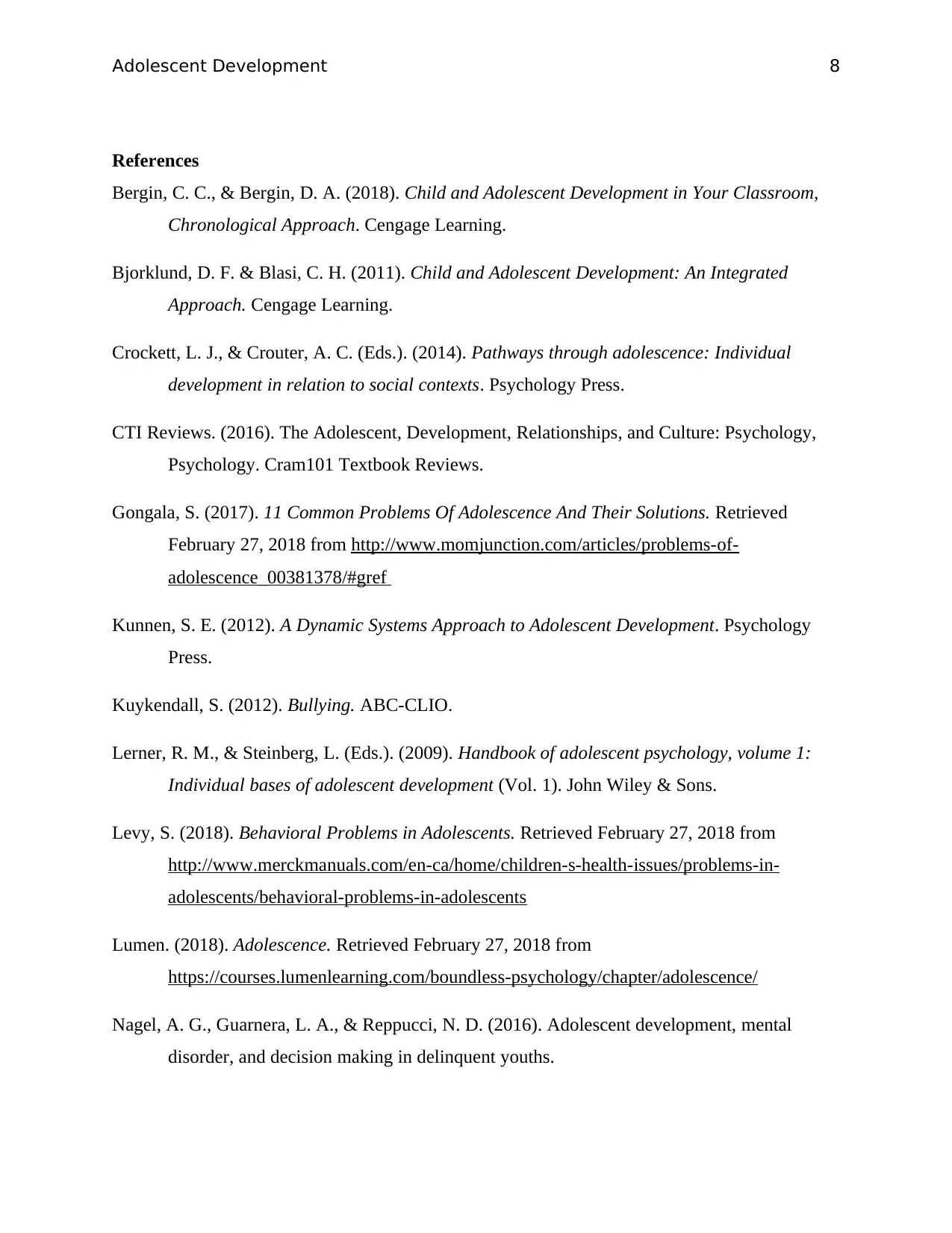
Adolescent Development 8
References
Bergin, C. C., & Bergin, D. A. (2018). Child and Adolescent Development in Your Classroom,
Chronological Approach. Cengage Learning.
Bjorklund, D. F. & Blasi, C. H. (2011). Child and Adolescent Development: An Integrated
Approach. Cengage Learning.
Crockett, L. J., & Crouter, A. C. (Eds.). (2014). Pathways through adolescence: Individual
development in relation to social contexts. Psychology Press.
CTI Reviews. (2016). The Adolescent, Development, Relationships, and Culture: Psychology,
Psychology. Cram101 Textbook Reviews.
Gongala, S. (2017). 11 Common Problems Of Adolescence And Their Solutions. Retrieved
February 27, 2018 from http://www.momjunction.com/articles/problems-of-
adolescence_00381378/#gref
Kunnen, S. E. (2012). A Dynamic Systems Approach to Adolescent Development. Psychology
Press.
Kuykendall, S. (2012). Bullying. ABC-CLIO.
Lerner, R. M., & Steinberg, L. (Eds.). (2009). Handbook of adolescent psychology, volume 1:
Individual bases of adolescent development (Vol. 1). John Wiley & Sons.
Levy, S. (2018). Behavioral Problems in Adolescents. Retrieved February 27, 2018 from
http://www.merckmanuals.com/en-ca/home/children-s-health-issues/problems-in-
adolescents/behavioral-problems-in-adolescents
Lumen. (2018). Adolescence. Retrieved February 27, 2018 from
https://courses.lumenlearning.com/boundless-psychology/chapter/adolescence/
Nagel, A. G., Guarnera, L. A., & Reppucci, N. D. (2016). Adolescent development, mental
disorder, and decision making in delinquent youths.
References
Bergin, C. C., & Bergin, D. A. (2018). Child and Adolescent Development in Your Classroom,
Chronological Approach. Cengage Learning.
Bjorklund, D. F. & Blasi, C. H. (2011). Child and Adolescent Development: An Integrated
Approach. Cengage Learning.
Crockett, L. J., & Crouter, A. C. (Eds.). (2014). Pathways through adolescence: Individual
development in relation to social contexts. Psychology Press.
CTI Reviews. (2016). The Adolescent, Development, Relationships, and Culture: Psychology,
Psychology. Cram101 Textbook Reviews.
Gongala, S. (2017). 11 Common Problems Of Adolescence And Their Solutions. Retrieved
February 27, 2018 from http://www.momjunction.com/articles/problems-of-
adolescence_00381378/#gref
Kunnen, S. E. (2012). A Dynamic Systems Approach to Adolescent Development. Psychology
Press.
Kuykendall, S. (2012). Bullying. ABC-CLIO.
Lerner, R. M., & Steinberg, L. (Eds.). (2009). Handbook of adolescent psychology, volume 1:
Individual bases of adolescent development (Vol. 1). John Wiley & Sons.
Levy, S. (2018). Behavioral Problems in Adolescents. Retrieved February 27, 2018 from
http://www.merckmanuals.com/en-ca/home/children-s-health-issues/problems-in-
adolescents/behavioral-problems-in-adolescents
Lumen. (2018). Adolescence. Retrieved February 27, 2018 from
https://courses.lumenlearning.com/boundless-psychology/chapter/adolescence/
Nagel, A. G., Guarnera, L. A., & Reppucci, N. D. (2016). Adolescent development, mental
disorder, and decision making in delinquent youths.
⊘ This is a preview!⊘
Do you want full access?
Subscribe today to unlock all pages.

Trusted by 1+ million students worldwide
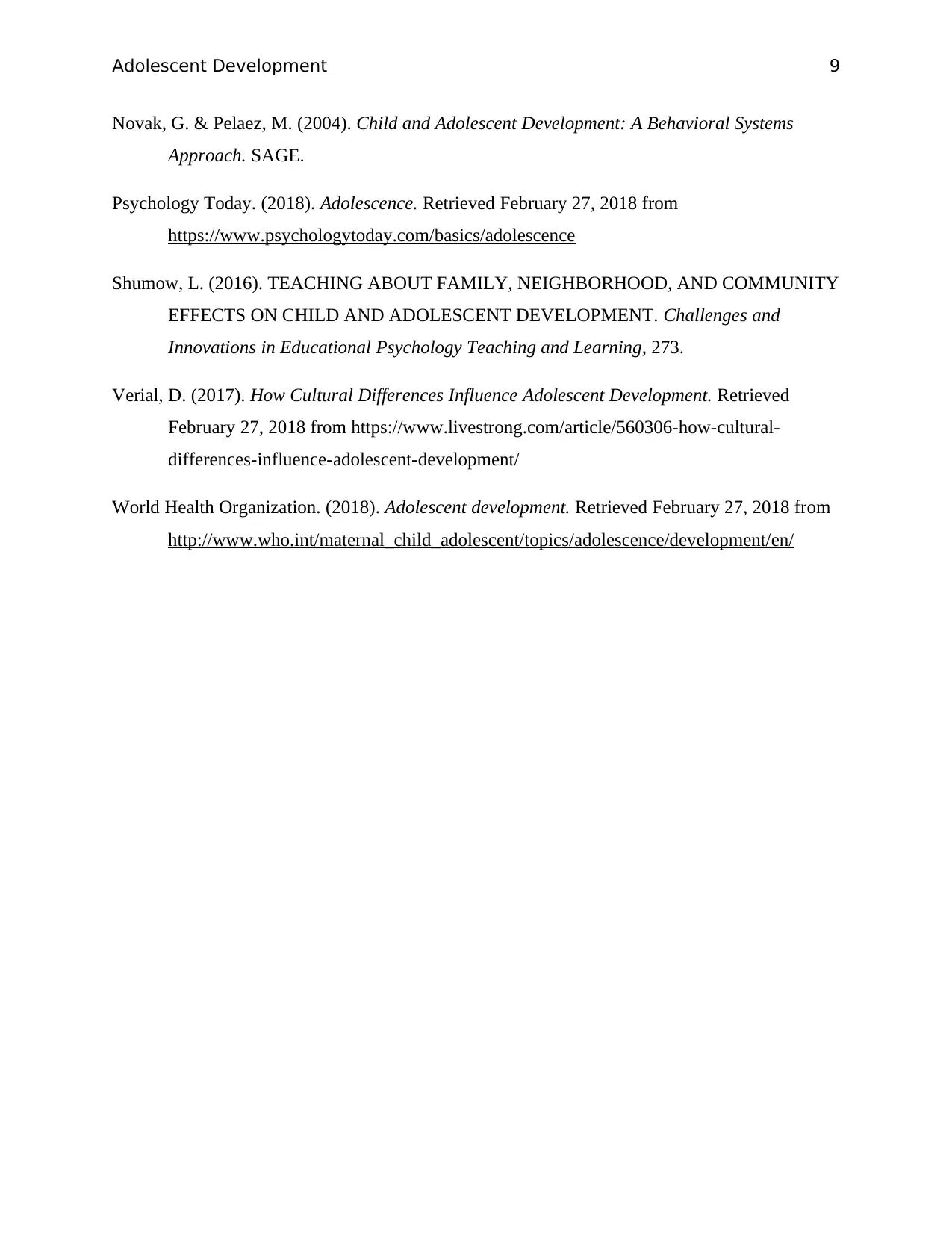
Adolescent Development 9
Novak, G. & Pelaez, M. (2004). Child and Adolescent Development: A Behavioral Systems
Approach. SAGE.
Psychology Today. (2018). Adolescence. Retrieved February 27, 2018 from
https://www.psychologytoday.com/basics/adolescence
Shumow, L. (2016). TEACHING ABOUT FAMILY, NEIGHBORHOOD, AND COMMUNITY
EFFECTS ON CHILD AND ADOLESCENT DEVELOPMENT. Challenges and
Innovations in Educational Psychology Teaching and Learning, 273.
Verial, D. (2017). How Cultural Differences Influence Adolescent Development. Retrieved
February 27, 2018 from https://www.livestrong.com/article/560306-how-cultural-
differences-influence-adolescent-development/
World Health Organization. (2018). Adolescent development. Retrieved February 27, 2018 from
http://www.who.int/maternal_child_adolescent/topics/adolescence/development/en/
Novak, G. & Pelaez, M. (2004). Child and Adolescent Development: A Behavioral Systems
Approach. SAGE.
Psychology Today. (2018). Adolescence. Retrieved February 27, 2018 from
https://www.psychologytoday.com/basics/adolescence
Shumow, L. (2016). TEACHING ABOUT FAMILY, NEIGHBORHOOD, AND COMMUNITY
EFFECTS ON CHILD AND ADOLESCENT DEVELOPMENT. Challenges and
Innovations in Educational Psychology Teaching and Learning, 273.
Verial, D. (2017). How Cultural Differences Influence Adolescent Development. Retrieved
February 27, 2018 from https://www.livestrong.com/article/560306-how-cultural-
differences-influence-adolescent-development/
World Health Organization. (2018). Adolescent development. Retrieved February 27, 2018 from
http://www.who.int/maternal_child_adolescent/topics/adolescence/development/en/
1 out of 10
Related Documents
Your All-in-One AI-Powered Toolkit for Academic Success.
+13062052269
info@desklib.com
Available 24*7 on WhatsApp / Email
![[object Object]](/_next/static/media/star-bottom.7253800d.svg)
Unlock your academic potential
Copyright © 2020–2025 A2Z Services. All Rights Reserved. Developed and managed by ZUCOL.





